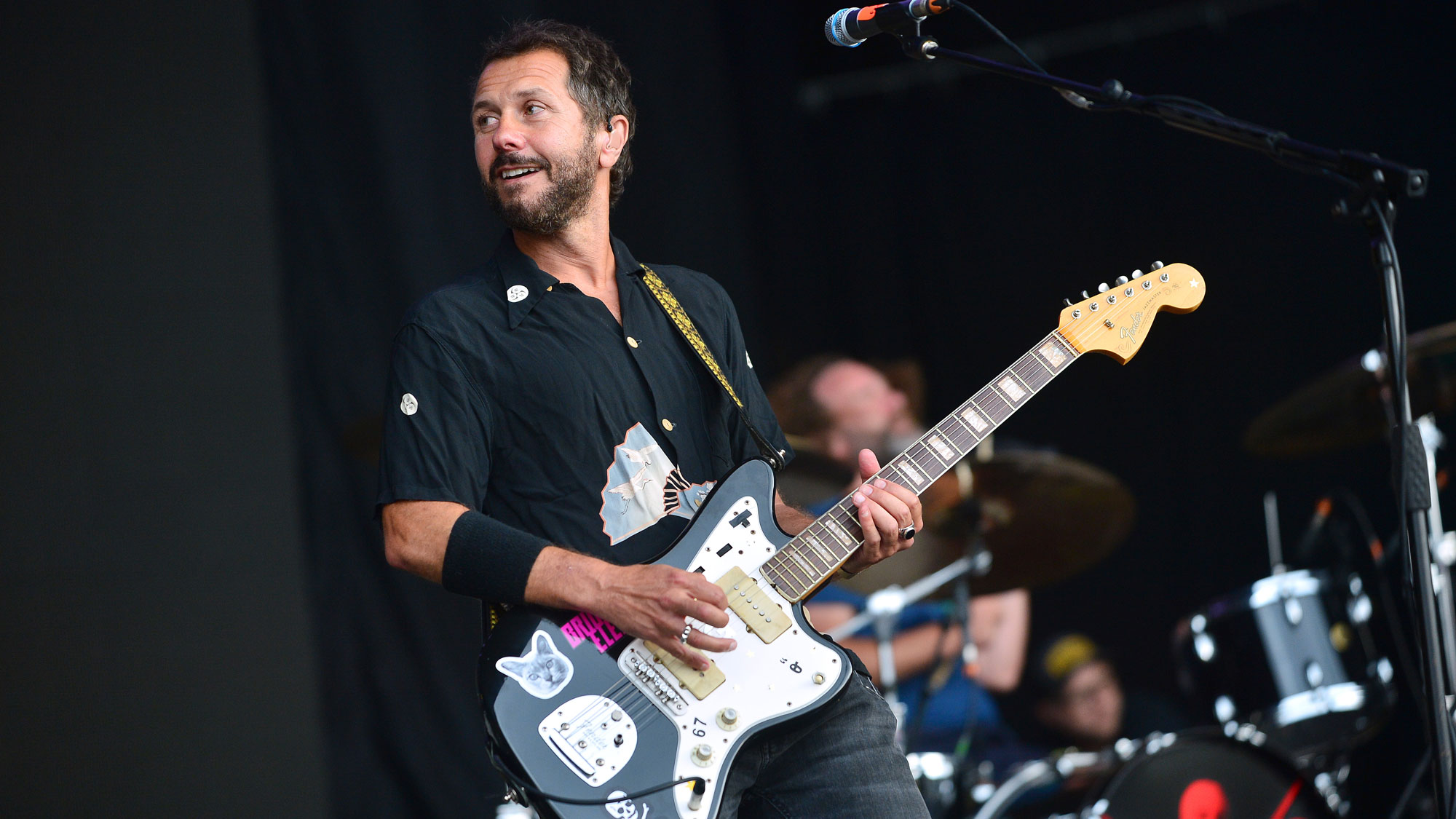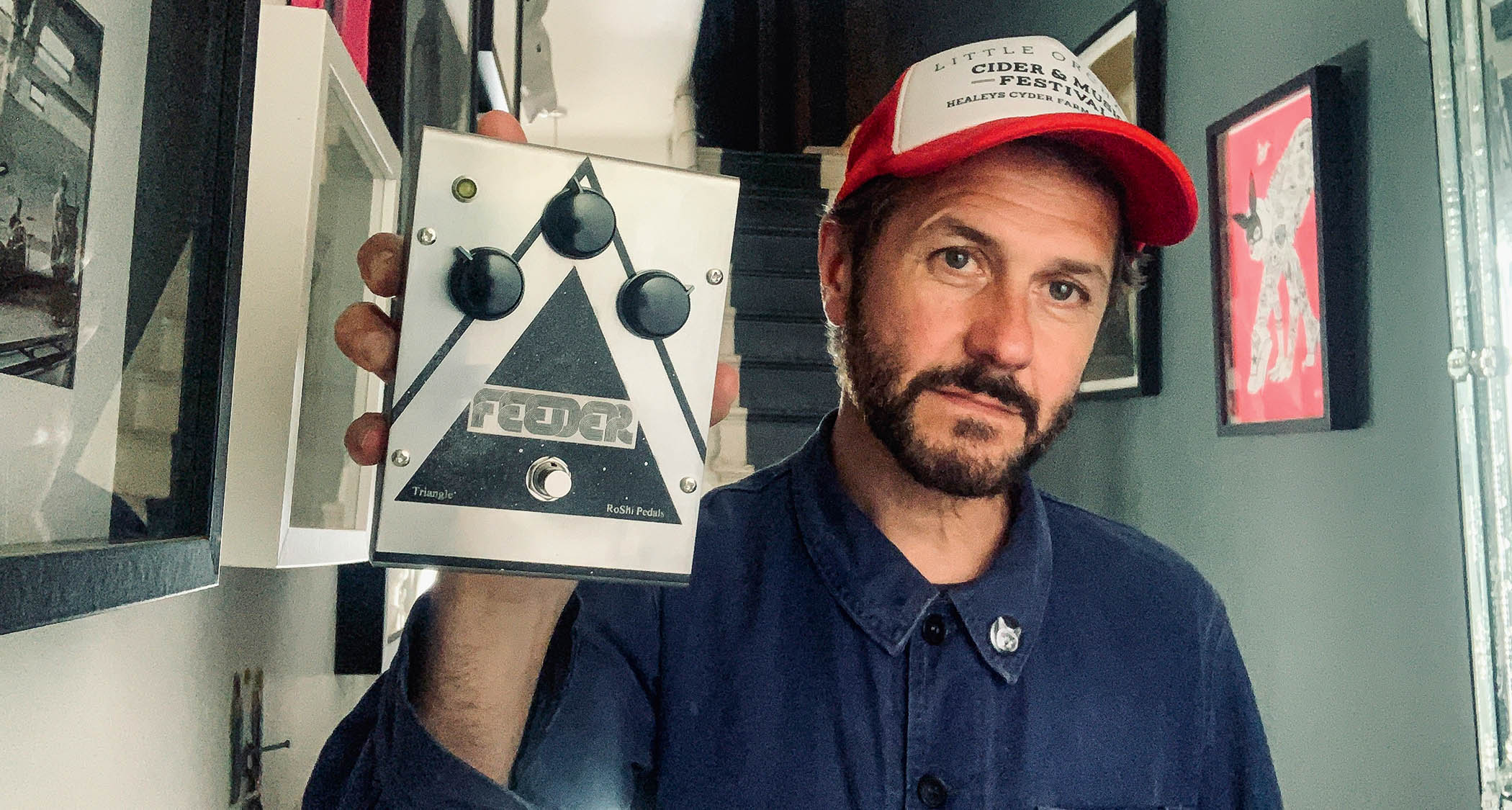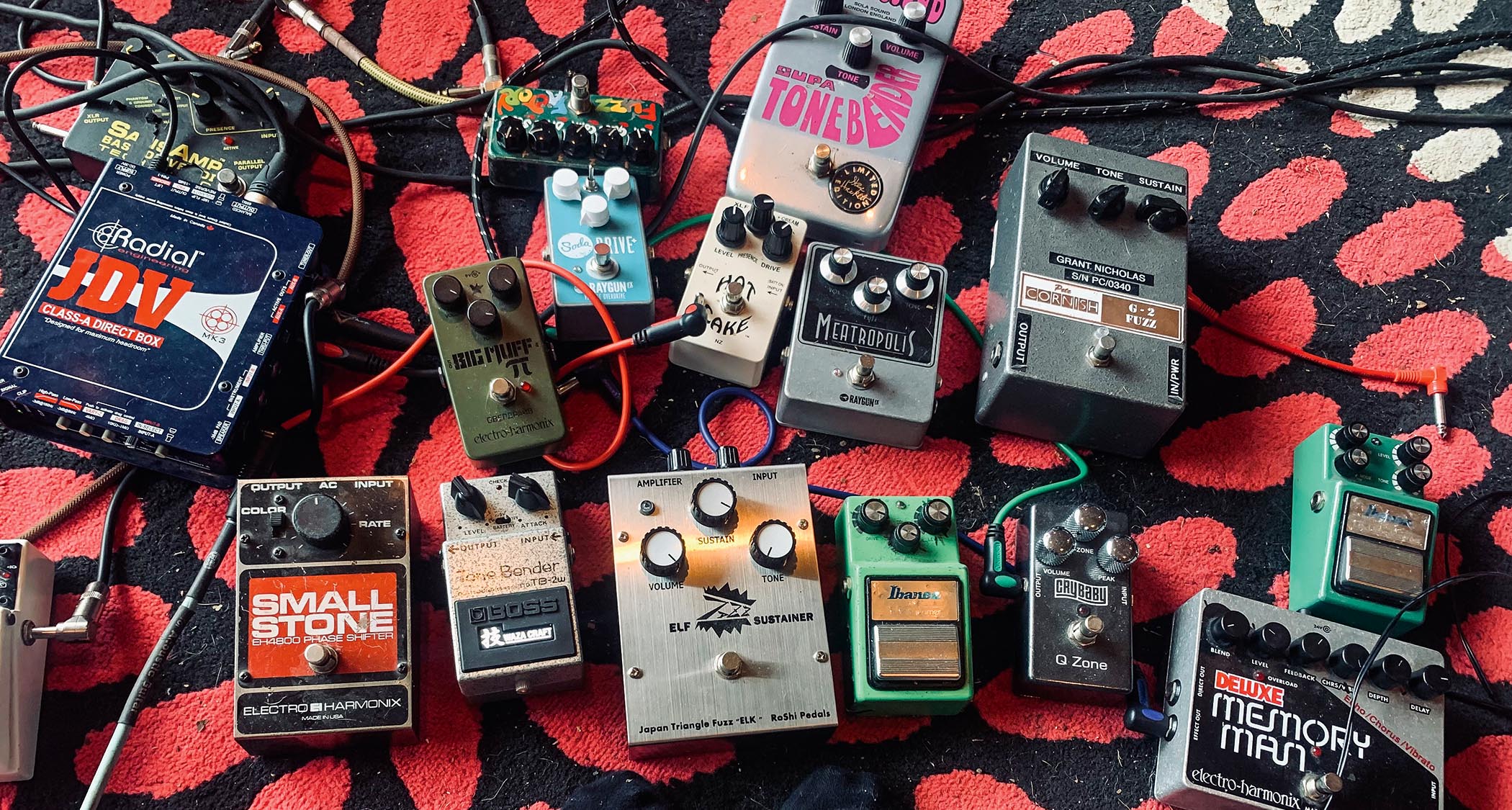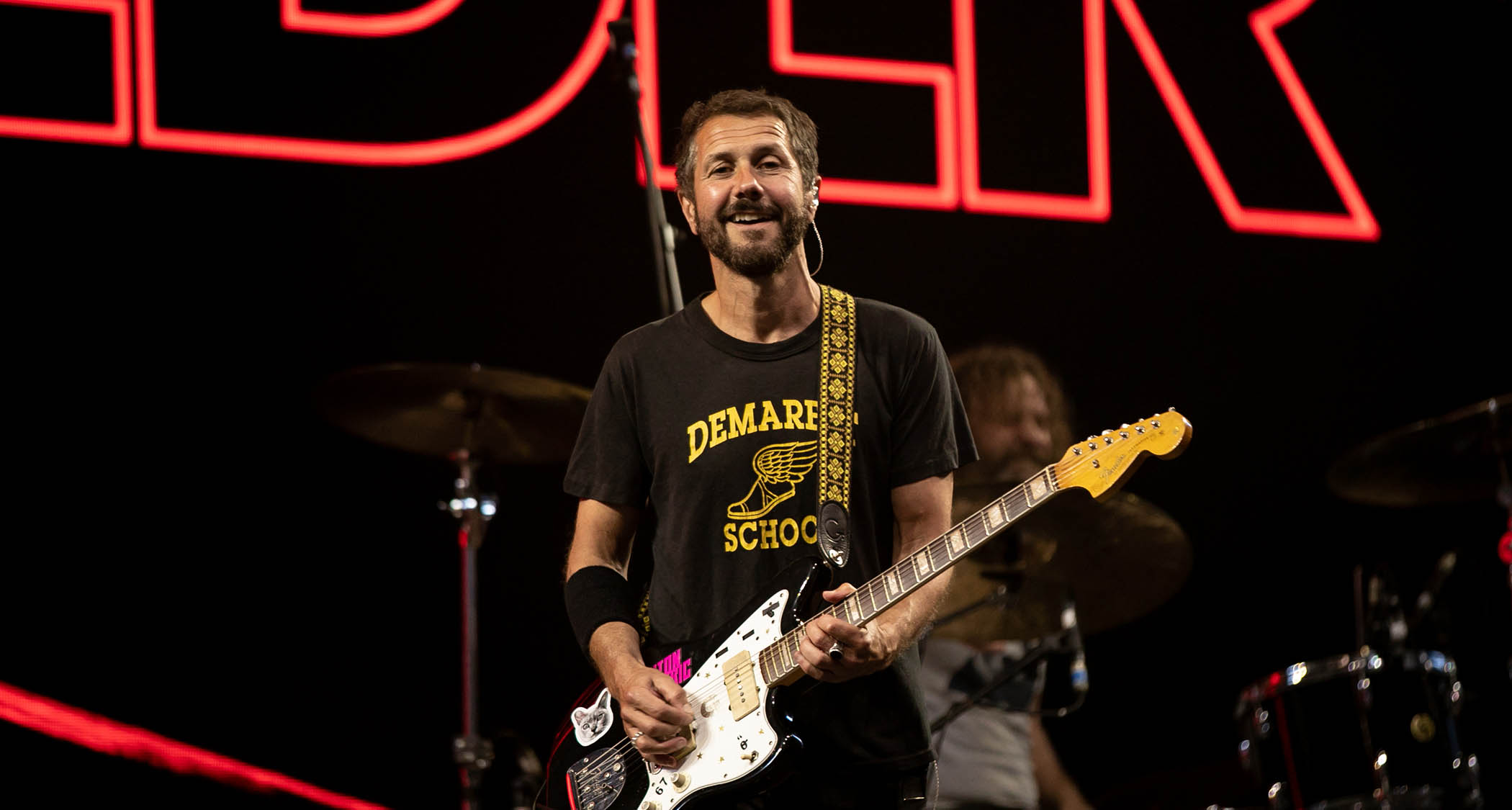
When Feeder released Polythene back in 1997, their debut album which produced five singles that remain fan favourites to this day, the Welsh group were hailed as the UK’s answer to The Smashing Pumpkins.
In similar ways to Billy Corgan and co., it was Feeder’s mix of heavy metal and dream pop that made them stand out of the crowd, appealing to rock fans of almost every kind. It’s why, in the decades since, they’ve shared stages with everyone from U2 and The Rolling Stones to Queens Of The Stone Age and Slipknot.
Feeder’s new release Black/Red is their first-ever double album – and, much like mid-’90s Smashing Pumpkins twin-masterpiece Mellon Collie And The Infinite Sadness, it takes listeners on a journey through hard riffing and kaleidoscopic reverie. As singer/guitarist Grant Nicholas explains, this is a band that still have plenty left to say…
“We’re lucky to have been going for 30 years and still feel creative,” he says. “I’m writing as much, if not more, as when we first started. I wanted to do a double album when we put out Torpedo in 2022 and then got cold feet, thinking we should just stick to a really good rock record. So I had all these ideas left over and more were coming. It felt like a body of work that belonged together, almost a trilogy in ways. It’s been one big journey!”
It’s been three decades since Feeder started, and comparisons to The Smashing Pumpkins still endure – which is perfectly understandable given your mutual love of fuzz…
“I can see why people would compare us to them. I’ve always loved Black Sabbath as well as the sound of Tone Benders and Big Muffs, which were big parts of the Pumpkins sound on albums like Siamese Dream. We’re from a similar ilk. We started around a similar time. I’m a similar age to Billy Corgan and probably grew up around similar artists.
“I think he’s into classic rock and AOR, but also other ’80s stuff. I look at my guitar more like a songwriter than a guitarist. I’m not a fancy lead player. I used to love Van Halen growing up and remember trying to work out Eruption. I was better back then than I am now. Like Billy, I’m more of a chord, riff and capo guy at heart.”
As well as fuzz pedals, both of your bands are known for using Fender offsets to introduce elements of indie and shoegaze within harder-hitting metallic structures…
Sometimes people have called us the British Foo Fighters, because we have that bouncy, heavy, indie side that fits in with bands like Hüsker Dü and Sugar
“We’re a heavy metal pop band! Black Sabbath were one of the first bands I fell in love with, but I was also into The Police, Kate Bush and Duran Duran. I love ’80s music, despite people saying it was bad! There was a lot of great songwriting and interesting production from that decade. And you know what? If it wasn’t for Gary Numan, we wouldn’t have bands like Nine Inch Nails.
“Sometimes people have called us the British Foo Fighters, because we have that bouncy, heavy, indie side that fits in with bands like Hüsker Dü and Sugar; or compare us to Cheap Trick. The great thing about Feeder is that we’re not just one thing. I love heavy stuff as much as that ’80s chorus sound.
“You can hear that on news songs like Hey You. It had that ’80s flavour, so I got my classic light blue Boss CE-2 chorus out. I own two and the one at home is really old, with a broken light.”
Which fuzz pedals did you rely on for the recent sessions?
“It’s a big part of the Feeder sound… I’m known for being a bit of a fuzz junkie! In the early days, I had quite a bizarre setup. I’d use an ADA preamp into a Vox AC30 or Fender twin, which you shouldn’t really do, and keep it on all the time. I’d then use various pedals to get heavy, something like a Big Muff to bring more saturation. I always call it my ‘hovercraft fuzz’ sound.
“My general distortion would be the programmed sound from the ADA. It was unique, but incredibly noisy and a pain in the arse. I moved onto the Tone Bender quickly after that and that’s my main fuzz sound, but I also use the green Russian Big Muff. I’ve got loads of Big Muffs but I find that one to be the best. I also use ELF fuzz pedals, hand-made by a guy in Japan…”

Hang on, there’s a track on the new album called ELF!
“Yeah! I loved the smoothness of his Tone Bender-style fuzz so much, I even named one of our tracks after it. The track’s quite proggy in places and ELF – when you spell out the letters – sounds like a prog song to me.
“The fuzz inspired the song and the title. It’s a small business, he’s a fan who contacted me asking if I’d try some of his pedals, and they’ve all been great. He also runs RoShi pedals, which is where he gets old pedals and has a look inside to see what they’re doing in order to recreate them. There are others I like, including stuff made by Raygun FX in the UK. I’ve got all kinds of Tone Benders, from originals to reissues to copies.”
Some purists get snobby about the TS9DX just because it’s not what Stevie Ray Vaughan used. But I prefer having options
You tend to like a lot of different options for gain – you’re only human, after all!
“I really like the Superbolt Overdrive made by JHS. It’s great for that edge of breakup tone. I also love the Boss Blues Driver, which is a really underrated pedal, but it has a lot of ballsy midrange. Another really underrated pedal I use all the time is my dark green Ibanez Tube Screamer TS9DX. It’s on virtually all of the Feeder albums.”
It’s the most versatile Tube Screamer, but doesn’t quite get the love it deserves because it’s not as traditional as, say, the TS808 or regular TS9.
“Exactly! Some purists get snobby about the TS9DX just because it’s not what Stevie Ray Vaughan used. But I prefer having options – it has the classic Tube Screamer mode, where you get the mid hump, plus another three on top. I still mainly stick with the original or + mode, which are the less gainy ones for more garagey sounds.
“I might even have the drive turned all the way down, just because it colours your tones in a certain way. Mine is actually a little bit knackered – if you tap one of the knobs, it drops to a half-level drive, and if you tap it again it goes back to normal. But that knackered setting has a really unique sound. That’s why I’ll never get it fixed! Crazy shit like that makes me happy.”

You clearly love your Jazzmasters. What is it about those quirky offset guitars that feel like home for you?
“When I started playing Jazzmasters, they actually weren’t very popular. Everyone thought I was playing Kurt Cobain’s guitar, and I’d have to correct them and say, ‘His was a Jaguar which has humbuckers!’ The good thing back then is that you could pick them up cheap. Now they’re a lot more expensive.
“I just love the shape of them. When you’re singing, it’s nice to have a guitar you feel comfortable with. I used to play SGs for a bit but found them too light. There’s something about a Jazzmaster that feels right to me. I like big guitars, even though I’m a small person. I prefer a bit of weight.”
What are the oldest and most desirable instruments in your collection?
“There’s my first one which I call ‘Jesus’. It’s the guitar most people know me for. That was my first Jazzmaster and I guess it’s my Holy Grail. I use it live all the time, but because it’s in lockup I don’t really use it on recordings. I’ve got two 1964 Silver Sparkle [models], all original except for the finish.
“My favourite era of Jazzmaster is 1966, so I’ve got two of those with the binding, square block inlays and bigger headstock. My main guitar for recording is an original 1959 Jazzmaster which I don’t take on the road. The pickups are super-low output, the trem is great and always stays in tune, so I use that to create a natural chorusing. Now I have a confession to make that might shock you…”

Spill the beans...
“I haven’t changed the strings on that guitar in eight years! They’re completely dead, but I just love the sound of it. If I need something with a bit more life, I’ll use a different one with newer strings, but there’s something about the sound of those old strings on that old guitar, it’s special.
When I think about the Feeder sound, it all comes down to Jazzmasters, Tone Benders, Big Muffs… and that broken Tube Screamer!
“With that I might use something like my Gibson Explorer with Seymour Duncan Antiquity pickups, which I’ve had since the early ’90s. Or I’ll use this ESP Custom guitar that was made for me. It sounds bizarre, but I told them I wanted it to be half Fender Mustang and half SG!
“It’s like an SG with a really chunky body and racing stripes, with a Jazzmaster backplate and trem, plus a bolt-on neck that feels quite solid and more like a Fender. I won’t use it live but it’s a beautiful guitar in a metallic bluey green.
“At one point I was using Telecasters for half the set, though now it’s Jazzmasters for everything. I still use Teles in the studio – there’s an old ’72 sunburst one that sounds great. And there’s an old ’60s Gibson ES-330 that I’ve used occasionally. But really, when I think about the Feeder sound, it all comes down to Jazzmasters, Tone Benders, Big Muffs… and that broken Tube Screamer!”
- Black/Red is out now via Big Teeth Music.







